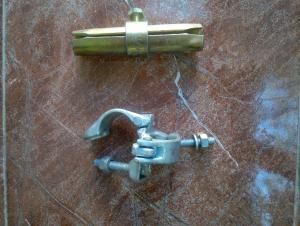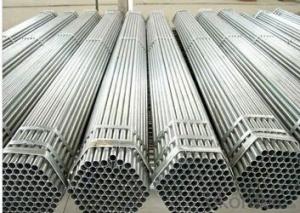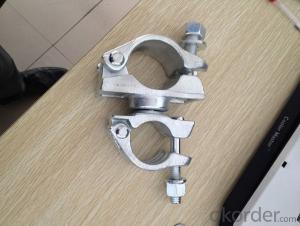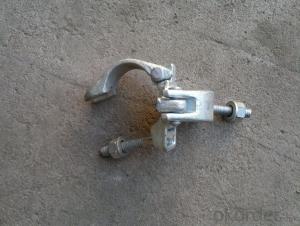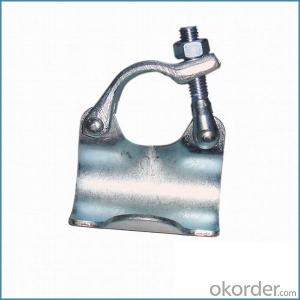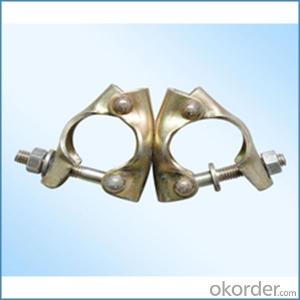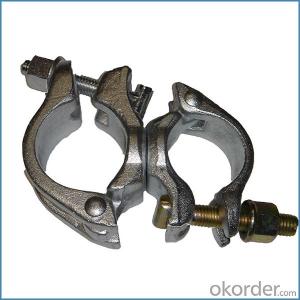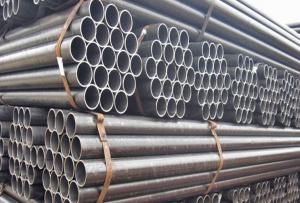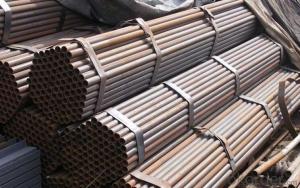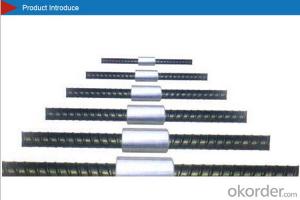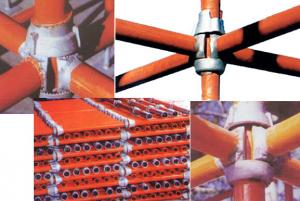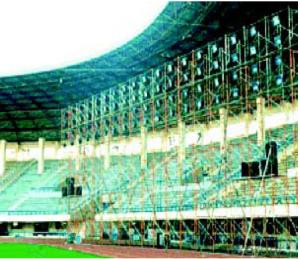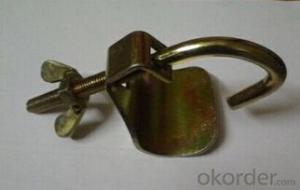Scaffolding Coupler Scaffolding Clamp british German Forged Type
- Loading Port:
- Tianjin
- Payment Terms:
- TT OR LC
- Min Order Qty:
- 1000 kg
- Supply Capability:
- 100000 kg/month
OKorder Service Pledge
OKorder Financial Service
You Might Also Like
Scaffolding Coupler Scaffolding Clamp british German Forged Type
Description
1.The scaffolding coupler is always used to connect the steel pipe as scaffolding system.
2.The often used coupler is swivel coupler and righ angle coupler .
3.We can provide types of scaffolding coupler according to your requirement.
4.Couoler can fix the 48.3mm scaffolding steel pipe tightly and make the whole scaffolding system more steadily.
Feature
(1)Excellent Anti-Breaking—Cold Pressed Steel
(2)Outstanding Resistance Deformation
(3)Strong Anti-Dropping Ability
Photo
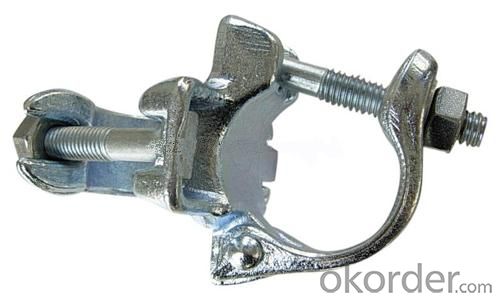
Parameter
| Material | Q235,345steel |
| Size | 48.3mm*48.3mm |
| Surface finish | Galvanized |
| Weight | 1.1kg around |
| Standard | BS1139,EN74 |
| Package | 25pcs/bag,steel pallet |
| Manufacture | As per customer requirement |
| Market | Africa, South America, the Middle East and Asia |
FAQ
Q: Are you a factory or trading company?
We are a state-owned corporation in China,dealing with various kinds of building materials.We have our holding subsidiaries.
Q: Where is your factory located? How can I visit there?
Our factory is located all around China.
Q: Can I get some samples?
Sample is free, customer only pay freight for the first time.
Q: Delivery?
10-30days. (5-15 containers)
Any question,feel free to contact us.
- Q:Can steel tube couplers be used with both steel and aluminum scaffolding tubes?
- Indeed, both steel and aluminum scaffolding tubes can be utilized in conjunction with steel tube couplers. These couplers have been meticulously crafted to interlink and firmly fasten scaffolding tubes constructed from diverse materials, such as steel and aluminum. Typically forged from top-notch steel, these couplers are engineered to establish a robust and reliable connection between the tubes. To guarantee a proper fit and promote a secure working environment, it is imperative to verify that the couplers are compatible with the precise size and dimensions of the scaffolding tubes employed.
- Q:How do you ensure the compatibility of steel tube couplers with other scaffolding components?
- To guarantee the compatibility of steel tube couplers with other scaffolding components, there are several measures that can be implemented: 1. Standards and Regulations: The initial step involves confirming that the steel tube couplers adhere to the required standards and regulations established by relevant authorities. This entails verifying if the couplers meet safety and load-bearing prerequisites, as well as any specific standards designated for scaffolding components. 2. Manufacturer's Recommendations: It is imperative to meticulously adhere to the manufacturer's recommendations for the steel tube couplers. This includes using the couplers solely with compatible scaffolding components specified by the manufacturer. Manufacturers typically provide comprehensive guidelines and compatibility charts to assist in selecting the appropriate components for a secure and stable scaffolding system. 3. Interchangeability Testing: If utilizing components from different manufacturers, conducting interchangeability testing is crucial. This entails testing the compatibility between the steel tube couplers and other scaffolding components to ensure a snug fit and dependable performance. The testing should encompass load-bearing capacity, alignment, and stability. 4. Documentation and Certification: Maintain detailed documentation of the specific steel tube couplers and scaffolding components employed in the project. This involves retaining certificates, test reports, and compliance documents from manufacturers. Proper documentation guarantees traceability and facilitates the verification of component compatibility. 5. Inspection and Maintenance: Regularly inspect and maintain the steel tube couplers and other scaffolding components to ensure their ongoing compatibility. This includes checking for any indications of wear, damage, or deterioration that may impact compatibility or performance. Promptly replace any worn or damaged components. 6. Training and Education: Proper training and education of scaffolding workers are pivotal in ensuring their comprehension of the significance of using compatible components and adhering to manufacturer's recommendations. This can help prevent errors and ensure the safety and longevity of the scaffolding system. By adhering to these measures, one can ensure the compatibility of steel tube couplers with other scaffolding components, thereby providing a secure and dependable scaffolding system for construction and other applications.
- Q:Can steel tube couplers be used in both tube and fitting scaffolding systems?
- Steel tube couplers have the ability to be utilized in both tube and fitting scaffolding systems, providing a versatile solution for securely connecting steel tubes. They have been specifically designed to ensure a secure connection and are commonly employed in different types of scaffolding systems, including tube and fitting systems. These couplers play a vital role in joining horizontal, vertical, and diagonal tubes, thereby guaranteeing the stability and structural integrity of the scaffold. Whether it is a tube and fitting system or any other scaffolding system utilizing steel tubes, steel tube couplers offer compatibility and effectiveness.
- Q:Are steel tube couplers adjustable for different angles in scaffolding?
- No, steel tube couplers are not adjustable for different angles in scaffolding. They are fixed connectors that securely join steel tubes together at a specific angle.
- Q:Are there any specific safety precautions to consider when using steel tube couplers?
- Yes, there are several safety precautions to consider when using steel tube couplers. Firstly, it is important to ensure that the couplers are properly installed and secured according to the manufacturer's instructions. This typically involves tightening the bolts to the specified torque and using the correct type and size of bolts. It is also crucial to inspect the couplers and surrounding components regularly for any signs of wear, damage, or corrosion. Any damaged or worn couplers should be replaced immediately to avoid potential structural failures or accidents. Another safety precaution is to ensure that the couplers are used within their intended load capacity. Overloading the couplers can lead to structural failures, so it is important to calculate and adhere to the maximum load limits specified by the manufacturer. Additionally, when working with steel tube couplers, it is important to use proper personal protective equipment (PPE) such as gloves, safety glasses, and steel-toed boots to protect against potential injuries. It is also advisable to follow safe handling practices, such as using lifting equipment when necessary and avoiding sharp or sudden movements that could cause injury. Lastly, it is crucial to follow all applicable safety regulations and standards when using steel tube couplers. This includes ensuring that the couplers are used in compliance with local building codes, industry standards, and any specific regulations related to the project or application. By considering these safety precautions, users can minimize the risk of accidents, injuries, and structural failures when working with steel tube couplers.
- Q:What is the maximum load capacity of a steel tube coupler?
- The maximum load capacity of a steel tube coupler is influenced by various factors, including the size and grade of the steel, the design and dimensions of the coupler, and the specific application it is used in. Construction and scaffolding systems commonly utilize steel tube couplers to connect and support tubes or pipes, providing stability and strength. To determine the maximum load capacity, it is crucial to consider the manufacturer's specifications. These specifications typically include load charts or tables that outline the safe working loads for different sizes and types of couplers. These specifications take into account factors such as the material's yield strength, applied safety factors, and the distribution of the load across the coupler. For instance, a typical steel tube coupler may have a maximum load capacity that varies from a few hundred kilograms to several tons, depending on its size and design. Adhering to these load limits is critical to ensure the safety and integrity of the structure or scaffolding system. When determining the maximum load capacity of a steel tube coupler for a specific application, it is important to consult the manufacturer's guidelines, perform engineering calculations, or seek professional advice from structural engineers or scaffolding experts. This approach ensures compliance with safety regulations and guarantees the structural stability of the system under expected loads.
- Q:Scaffolding by probability limit state design of what the expression
- The calculation of the strength of components, stability and connection strength, the load should be used in the basic combination of design values Permanent load factor should take 1 variable load factor should take 14 scaffold in the bending component, should still be based on the normal use of the limits of the state requirements of deformation Check the deformation of the components, the load should be used in the standard combination of design values, all kinds of load factor should be taken 10 when the vertical or horizontal horizontal axis of the axis of the opposite axis of the eccentricity of not more than 55mm, the pole The effect of this eccentricity is not taken into account in the stability calculation when the use of "construction fastener steel scaffold safety technical specifications" Article 611 of the structural size, the corresponding bar can no longer design calculations But even wall pieces, pole foundation bearing capacity should be based on the actual load design calculation the strength of steel design value and elastic modulus should be "construction of fastener steel scaffold safety technical specifications" Table 516 use fasteners, base, adjustable support bearing capacity design value should be "construction construction fastener steel scaffold safety technical specifications" Table 517 used 8 The deflection of the bending member shall not exceed the allowable value specified in Table 518 of the Technical Code for Safety of Fasteners for Construction Fastener Steel Scaffolding 9 The slenderness ratio of the compression and tension members shall not exceed the permissible values ??specified in Table 519 of the Technical Code for Safety of Fasteners for Construction Fastener Steel Scaffolding
- Q:It's easy to get it done a little into the holidays, so it has six weeks without being tampered with at all but then I go back to school and here is the problem - my school are really particular about piercings, I am, after all, only 14. My hair is long, and I could cover it - especially if they were just studs.
- You really shouldn't get the studs. The holes won't be properly aligned, and that will cause a lot of stress/trauma when you put in the bar. I would suggest just wearing your hair down from now on. Industrials are infamously finicky. I would wait a *least* a year and a half before taking it out for longer than a minute or two.
- Q:How do you dismantle scaffolding with steel tube couplers?
- To dismantle scaffolding with steel tube couplers, you should follow these steps: 1. Start by removing all planks and boards from the scaffold platform. 2. Unscrew and remove all diagonal and horizontal braces that connect the scaffold frames. 3. Loosen and disconnect the steel tube couplers using a wrench or scaffold spanner. 4. Carefully disassemble the scaffold frames by removing the vertical tubes one by one. 5. As you remove each tube, make sure to lower it safely to the ground to avoid any accidents. 6. Continue dismantling the frames until all tubes and couplers are removed. 7. Store the tubes and couplers in a safe and organized manner for future use or proper disposal. Remember to always follow safety guidelines and use appropriate personal protective equipment (PPE) when working with scaffolding. It is crucial to have a trained and experienced individual supervise the dismantling process to ensure it is done correctly and safely.
- Q:Can steel tube couplers be used in scaffolding projects with limited foundation options?
- When faced with limited options for foundations, scaffolding projects can still make use of steel tube couplers. These versatile components are capable of connecting steel tubes of varying sizes and lengths, providing flexibility in the design of scaffolding structures. They prove particularly useful in situations where traditional foundation choices like concrete footings are not feasible. By utilizing steel tube couplers, stable and secure scaffolding structures can be created in scenarios with limited foundation choices. These couplers establish a strong and dependable connection between steel tubes, guaranteeing the overall stability and safety of the scaffolding system. Moreover, steel tube couplers are easy to both install and dismantle, which makes them ideal for temporary scaffolding projects. They can be adjusted and reconfigured as needed to accommodate different site conditions and layout requirements. When employing steel tube couplers in scaffolding projects with limited foundation options, it is crucial to consider the specific requirements and limitations of the project at hand. Seeking guidance from a structural engineer or a scaffolding specialist is strongly recommended to ensure the proper design and installation of the scaffolding system.
1. Manufacturer Overview |
|
|---|---|
| Location | |
| Year Established | |
| Annual Output Value | |
| Main Markets | |
| Company Certifications | |
2. Manufacturer Certificates |
|
|---|---|
| a) Certification Name | |
| Range | |
| Reference | |
| Validity Period | |
3. Manufacturer Capability |
|
|---|---|
| a)Trade Capacity | |
| Nearest Port | |
| Export Percentage | |
| No.of Employees in Trade Department | |
| Language Spoken: | |
| b)Factory Information | |
| Factory Size: | |
| No. of Production Lines | |
| Contract Manufacturing | |
| Product Price Range | |
Send your message to us
Scaffolding Coupler Scaffolding Clamp british German Forged Type
- Loading Port:
- Tianjin
- Payment Terms:
- TT OR LC
- Min Order Qty:
- 1000 kg
- Supply Capability:
- 100000 kg/month
OKorder Service Pledge
OKorder Financial Service
Similar products
New products
Hot products
Hot Searches
